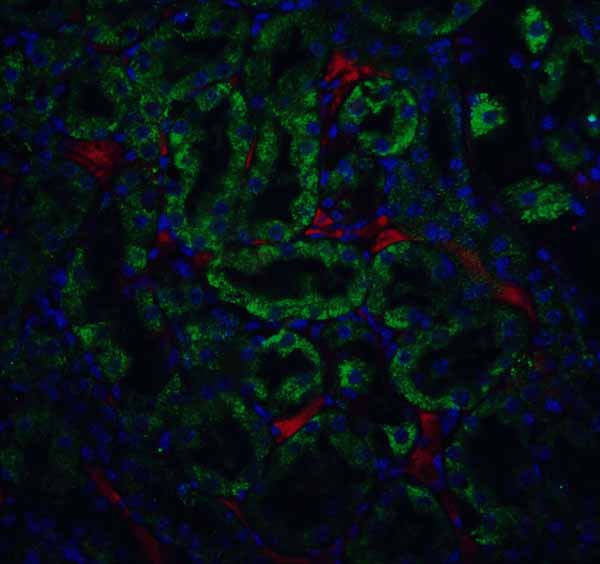IEX-1 Antibody
- SPECIFICATION
- CITATIONS
- PROTOCOLS
- BACKGROUND

Application
| WB, IHC-P, IF, E |
|---|---|
| Primary Accession | P46695 |
| Other Accession | P46695, 8870 |
| Reactivity | Human, Mouse |
| Host | Rabbit |
| Clonality | Polyclonal |
| Isotype | IgG |
| Calculated MW | 16903 Da |
| Application Notes | IEX1 antibody can be used for detection of IEX1 by Western blot at 1 - 2 μg/mL. Antibody can also be used for immunohistochemistry starting at 2.5 μg/mL. For immunofluorescence start at 20 μg/mL. |
| Gene ID | 8870 |
|---|---|
| Target/Specificity | IEX1 antibody was raised against a 24 amino acid synthetic peptide near the center of human IEX1. The immunogen is located within amino acids 40 - 90 of IEX-1. |
| Reconstitution & Storage | IEX-1 antibody can be stored at 4℃ for three months and -20℃, stable for up to one year. As with all antibodies care should be taken to avoid repeated freeze thaw cycles. Antibodies should not be exposed to prolonged high temperatures. |
| Precautions | IEX-1 Antibody is for research use only and not for use in diagnostic or therapeutic procedures. |
| Name | IER3 |
|---|---|
| Synonyms | DIF2, IEX1, PRG1 |
| Function | May play a role in the ERK signaling pathway by inhibiting the dephosphorylation of ERK by phosphatase PP2A-PPP2R5C holoenzyme. Also acts as an ERK downstream effector mediating survival. As a member of the NUPR1/RELB/IER3 survival pathway, may provide pancreatic ductal adenocarcinoma with remarkable resistance to cell stress, such as starvation or gemcitabine treatment. |
| Cellular Location | Membrane; Single- pass type II membrane protein |

Thousands of laboratories across the world have published research that depended on the performance of antibodies from Abcepta to advance their research. Check out links to articles that cite our products in major peer-reviewed journals, organized by research category.
info@abcepta.com, and receive a free "I Love Antibodies" mug.
Provided below are standard protocols that you may find useful for product applications.
Background
IEX-1 Antibody: IEX-1 is a stress inducible gene that is induced by ionizing radiation, ultraviolet radiation, and a variety of growth factors, i.e., FAS and TNF-α. IEX-1 is widely expressed in epithelial and endocrine tissues, as well as in vascular endothelium. It plays an important role in the regulation of cellular growth, cell death and oncogenesis. IEX-1 is precisely regulated by multiple transcription factors such as p53, NF-κB/rel, Sp1 and c-Myc, to ensure rapid and transient expression of IEX-1 in cells under a variety of stress conditions. IEX-1 is expressed as both a longer form (IEX1L) and a splice variant, designated IEX1S. It is localized to the nucleus and perinuclear region. Overexpression of IEX-1 facilitates apoptosis and cell cycle progression, whereas disruption of IEX-1 expression is associated with decreases in both apoptosis and cell cycle progression.
References
Kondratyev AD, Chung K-N and Jung MO. Identification and characterization of a radiation-inducible glycosylated human early-response gene. Cancer Res.1996; 56:1498-502.
Feldmann KA, Piddelkow MR, Roche PC, et al. Expression of an immediate early gene, IEX-1, in human tissues. Histochem. Cell Biol.2001; 115:489-97.
Wu MX, Zhaohui A, Prasad KVS, et al. IEX-1L, an apoptosis inhibitor involved in NFkappaB mediated cell survival. Science1998; 281:998-1001.
Arlt A, Grobe O, Sieke A, et al. Expression of the NF-kappa B target gene IEX-1 (p22/PRG1) does not prevent cell death but instead triggers apoptosis in Hela cells. Oncogene2001; 20:69-76.
If you have used an Abcepta product and would like to share how it has performed, please click on the "Submit Review" button and provide the requested information. Our staff will examine and post your review and contact you if needed.
If you have any additional inquiries please email technical services at tech@abcepta.com.













 Foundational characteristics of cancer include proliferation, angiogenesis, migration, evasion of apoptosis, and cellular immortality. Find key markers for these cellular processes and antibodies to detect them.
Foundational characteristics of cancer include proliferation, angiogenesis, migration, evasion of apoptosis, and cellular immortality. Find key markers for these cellular processes and antibodies to detect them. The SUMOplot™ Analysis Program predicts and scores sumoylation sites in your protein. SUMOylation is a post-translational modification involved in various cellular processes, such as nuclear-cytosolic transport, transcriptional regulation, apoptosis, protein stability, response to stress, and progression through the cell cycle.
The SUMOplot™ Analysis Program predicts and scores sumoylation sites in your protein. SUMOylation is a post-translational modification involved in various cellular processes, such as nuclear-cytosolic transport, transcriptional regulation, apoptosis, protein stability, response to stress, and progression through the cell cycle. The Autophagy Receptor Motif Plotter predicts and scores autophagy receptor binding sites in your protein. Identifying proteins connected to this pathway is critical to understanding the role of autophagy in physiological as well as pathological processes such as development, differentiation, neurodegenerative diseases, stress, infection, and cancer.
The Autophagy Receptor Motif Plotter predicts and scores autophagy receptor binding sites in your protein. Identifying proteins connected to this pathway is critical to understanding the role of autophagy in physiological as well as pathological processes such as development, differentiation, neurodegenerative diseases, stress, infection, and cancer.


